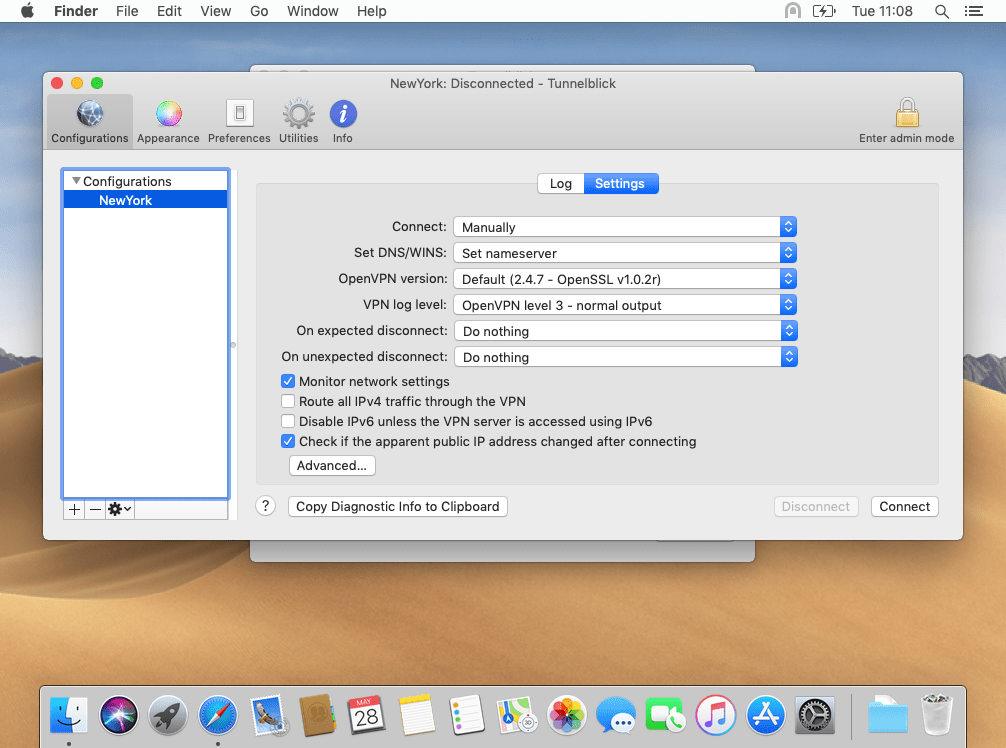

Your username is basically the email address of your ZoogVPN account. Under ‘Authentication Settings’ enter your ZoogVPN account credentials. Step 6 – Change ‘Authentication Settings’ To ensure fast internet speed, it’s recommended to connect to the nearest VPN server.Ĭlick on the ‘Authentication Settings…’ button. For example server address can look like this: nl. You can find all available server addresses in your account here. Step 5 – VPN Settingsįor ‘Server Address’ and ‘Remote ID’ choose a VPN server to enter the Server Address. Once entered click on the ‘Create’ button. Step 4 – Select Interface & Enter Service Nameįor ‘Interface’ select ‘VPN’, for ‘VPN Type’ select ‘IKEv2’ and for ‘Service Name’ enter ‘ZoogVPN IKEv2’. Step 3 – Create VPN ConnectionĬlick ‘+’ to create a new VPN connection. In the ‘System Preferences’ window, click on the ‘Network’ icon. Works with macOS 10.11+ (Version: 1.0, Beta) Step 1 – Click on ‘System PreferencesĬlick on ‘System Preferences’ on your Mac’s dock. Didn’t find an answer to your question? Contact our 24/7 customer support team here. We strongly encourage Free Plan users to show their support on social media. Once the download completes double click to uninstall your current version of Tunnelblick.Įnjoy! You have now taken control of your Internet freedom, privacy, and security.ĭon’t forget to connect with us on Facebook and Twitter. Uninstalling Tunelblick OpenVPN ClientĬlick the ‘DOWNLOAD’ button below to download Tunnelblick Uninstaller. You may need to press the ‘Refresh’ button for it to appear. To disconnect click on the ‘Disconnect’ button on the status screen (above) or click on the Zoog VPN Tunnelblick Client icon on the Finder bar, followed by ‘Disconnect’.Ĭheck that the flag next to your username has now turned to your desired server country flag. Upon successful connection, you will see a screen with a confirmation of successful connection. You can also tick ‘Save In Keychain’ for the client to remember your login details. Your password is the password you used when creating your ZoogVPN account. You will then be asked to enter your ZoogVPN account credentials. NB: To launch Tunnelblick Client, if not already running, go to Launchpad and click on ‘Tunnelblick’.Īccept all the system prompts to complete the import. Step 4 – Launching Zoog VPN Tunnelblick Client Unzip the archive file, to import the configuration files, simply select all, right-click and choose ‘Open with Tunnelblick’. You can find the list of available servers here. We recommend using ‘TCP’ only when ‘UDP’ is not available or when a more secure VPN connection is required. Single File Download – Choose your desired location and tap on the Download icon to download the OpenVPN configuration file. Unzip the archive file and save the folder on your device’s SD card for later use. Step 2 – Download Configuration Filesīulk Download – On your macOS device download OpenVPN Configuration Files. Once the download is complete, double click on the. Click on a VPN server to connect.Įnter your account ID that begins with letters ‘ivpnXXXXXXXX’ or ‘i-XXXX-XXXX-XXXX’ and any password.Works with macOS 10.11+ (Version: 1.0, Beta) Step 1 – Download Tunnelblick OpenVPN ClientĬlick the ‘Download Tunnelblick’ button and choose ‘Stable’ release from the Tunnelblick website. Click this icon and you will be presented with a list of VPN servers that you have imported. You will notice a new status menu icon that looks like a tunnel. Next you will be asked to enter your macOS password to import the configurations. Select whether you want to enable the connections for only yourself or for all users of your computer.


Select all the files, right-click one of them and select open with / tunnelblick.app. Unzip the downloaded file and then open the new ivpn-openvpn-config folder. When the installer asks if you want to launch or quit Tunnelblick, click Quit.ĭownload the IVPN config files. You may see a warning about Tunnelblick being downloaded from the Internet - Click open to continue. Double-click the Tunnelblick.app icon to install into your applications folder. Unless your version of macOS is not supported by the current stable release we always recommend using the stable release.ĭouble-click the downloaded. If you are using a pre-release version of macOS then you may need to download the beta release.


 0 kommentar(er)
0 kommentar(er)
